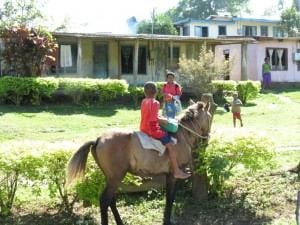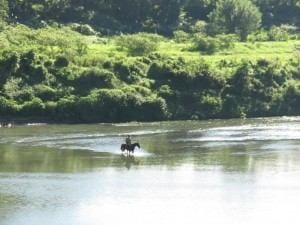Mention the name Fiji and what comes time mind? Honeymoons, anniversary trips, romantic escapes. With blue water and remote soft-sand beaches, Fiji screams romance. Can this country, seemingly designed for couples, be remotely suitable for families? Family travel contributor Dana Rebmann tests the waters and finds that bringing the kids lets you into the real heart of the country.
Fiji has 333 islands all together, about a third of which are inhabited. With a thousand miles of white sand beaches, there’s plenty of room for couples and children to have their own space. As your plane begins its descent into the Nadi, the main gateway to the country, passengers with window seats will have the best views in house. The seemingly neverending view of water and beaches has a way of energizing visitors, just before touch down.
Fiji’s People
There’s so many things to love about the Fijian people. As a society, they don’t live by their watches. English is the official language, but the further you venture from the bigger cities, into the villages, the more likely you are to hear Fijian spoken. They have a strong sense of family, community and obligation. Fijians like to talk, they like to smile and they love children.
“Children give us an excuse to act dopey,” said Elizabeth Powell Fiji’s Permanent Secretary for Tourism.
 Going to Fiji and not meeting its people would be like going to Fiji and not swimming in its bright blue water. For families visiting Nadi, one of the easiest ways to get a sense of village life is by joining a Sigatoka River Safari excursion. If you don’t have a rental car, a shuttle will pick you up from your hotel. The drive is about an hour long and a learning experience in itself. You’ll see a bit of Nadi, maybe even the Sri Siva Subramaniya Temple, the largest Hindu temple in the southern hemisphere. When you leave Nadi and make your way toward the Sigatoka River, the scenery changes. Fruit stands and farms replace storefronts. You’ll see farmers tending to their fields, not with tractors, but with the help of working animals. Don’t hesitate to stop and take a picture. Expect them to smile and wave as they work.
Going to Fiji and not meeting its people would be like going to Fiji and not swimming in its bright blue water. For families visiting Nadi, one of the easiest ways to get a sense of village life is by joining a Sigatoka River Safari excursion. If you don’t have a rental car, a shuttle will pick you up from your hotel. The drive is about an hour long and a learning experience in itself. You’ll see a bit of Nadi, maybe even the Sri Siva Subramaniya Temple, the largest Hindu temple in the southern hemisphere. When you leave Nadi and make your way toward the Sigatoka River, the scenery changes. Fruit stands and farms replace storefronts. You’ll see farmers tending to their fields, not with tractors, but with the help of working animals. Don’t hesitate to stop and take a picture. Expect them to smile and wave as they work.
After arriving at the dock, you’ll be fitted with a life jacket and on your way. The Sigatoka River Safari visits a different village Monday through Saturday, (there are no visits on Sunday for local religious observations) and villages are only allowed to participate for six months at a time to minimize the impact of tourists.
 Our Captain Leps stopped the boat from time to time as we made our way to Rarabahaga Village to tell us about the river environment and the area’s cannibal history. The cruise took us past women fishing, children playing and farmers tending to their animals. I don’t remember a single person not waving with enthusiasm.
Our Captain Leps stopped the boat from time to time as we made our way to Rarabahaga Village to tell us about the river environment and the area’s cannibal history. The cruise took us past women fishing, children playing and farmers tending to their animals. I don’t remember a single person not waving with enthusiasm.
The excitement continued as we walked down a stretch of primitive road into the village. It’s almost like stepping back in time. Kids came out of greet us and at times ran alongside the road, eager to have their picture taken. A boy riding his horse using nothing more than a rope announced our arrival to his family.
 Every village visit includes a kava ceremony and a traditional Fijian lunch prepared by the women of the village. Expect singing and dancing and smiling. Everyone smiles, especially the kids hovering in the background.
Every village visit includes a kava ceremony and a traditional Fijian lunch prepared by the women of the village. Expect singing and dancing and smiling. Everyone smiles, especially the kids hovering in the background.
It won’t take you or your kids long to realize the people in the village don’t have much, nor will you have to say much to your kids to drive home the lesson they have a great deal to be thankful for.
The jet safari boats are custom built for use on the Sigatoka River. On the return home, the captain will make more use of the giant horse power engines behind the boat. For thrill seekers and teenagers, there’s the chance to do some soaking high speed spins before ending your adventure.












